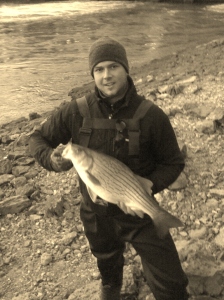As a novice angler I have heard a lot of, “you’ll never / you can’t / you’re doing it all wrong / you can’t catch / they don’t …. ( fill in the blank).” Some anglers think that they really do have it all figured out. If you ask them they are the experts, fish literally swim to the nearest phone and call them to find out what to eat, what kind of clothes they prefer, what brand of boat you must have, and a myriad of other mysterious questions.
What I have figured out is they are wrong. I’m totally sure of it, 100%. This is particularly true of fly fishing. Some anglers get blinded by the right way to do this and that. From reading the water, to what fish you can catch on a fly. You could write a book on how many different “best ways” to cast exist. There are hundreds, if not thousands of perfect methods out there. Many push their method as superior, or the only one usable and so on. I am sure that there are better ways than some and worse than others, but I think a lot of people in the sport are missing the point.
I can think of one instance in particular that happened to me personally, and I would venture that many people have encountered something similar. I was probably twelve at the time and had taken a trip to Bennett Springs, in Central Missouri during Easter with my family. I had a facination with fly fishing and convinced my mom to rent a fly rod for me from the visitors center there. I had no real experience with fly fishing, I had read magazines, watched some videos, but really this was my first time fly fishing.
I bought a few flies they recomended and made my way to the river. Thats where I encountered probably the biggest (fill in the blank) I have ever encountered while fishing. I will spare you the details but this guy pretty much ruined my day fishing single handedly. I didn’t pick up a fly rod again until I was in college and still don’t really personally care for trout fishing.
Long story short this guy at the river riducluded my casting, choice of fly, and told me that fishing that way wasnt really fly fishing for trout. My cast was ugly, still is. Who cares, and as for my choice of fly, which was a glo-ball, it worked. Who really cares if it didn’t match the latest hatch at the local “put and take” trout park. If the fly looks like food enough for the trout, it works just fine for me.
The reason I am taking note of any of this is not to gripe that I met a less than desireable character one day, or that there is a lot of debate as to the productivity of certain methods in fishing, but rather to draw attention to the need for innovation and creativity in fishing.
There are a lot of rules, especially in fly fishing, that exist that need to be broken or at least called into question. One “rule” that a lot of fly fishermen wouldn’t dare mess with is line selection. An 8wt. rod gets an 8 wt. line, no ifs’ and’s or but’s. But… that isn’t always true. I have encountered rods that casted better with heavier line, sometimes two weights heavier. It loaded better, it casted more accurately, and was better to fish with. There are times when going lower can help such as in the wind, where a smaller diameter will incurr less drag. I have never done it, but I am told it works well.
For some reason a lot of people look for rules to attach to fishing to make some kind of infalliable system for catching fish. You can’t. Fishing is extreamly dynamic no matter what method you use, fly fishing is no exception. I don’t think that it helps anyone to limit the imagination of the angler.
I also encourage you to try something slighly unorthodox that you may have been wondering about next time you’re out. Sometimes unexpected success can come out of an expirement. Last summer I was fishing the dog days of August for largemouth here that the Lake of the Ozarks having minimal luck. I was fishing 15-25′ deep using 10″ Texas rigged worms and jigs. When it gets hot and the fish seem to look for some relief deeper and thats how a lot of people go about trying to catch them. I was fishing afternoons and evenings after work not doing particularly well. As I was getting ready to call it a day or night really, I gave a last cast right up on shore, I’m talking the tail of the worm was on the bank out of the water, on shore. No sooner than I started to inch it into the water I had a fish on. This went on all night untill I packed up at about 11 pm. That pattern worked well for the remaining duration of the summer.
I am not trying to say that I invented something or found some crazy radical trick or that was a genious pattern or something like that. The point is I would have not had a great end to the summer last year if I had not tried something a little different. The next time you’re out give something a try, who knows it just may work.



